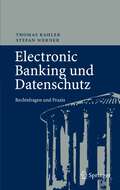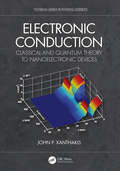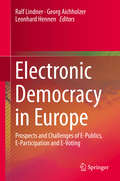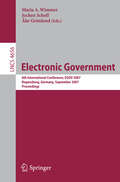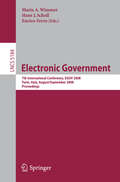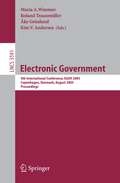- Table View
- List View
Electronic Band Structure Engineering and Ultrafast Dynamics of Dirac Semimetals (Springer Theses)
by Changhua BaoThis book highlights the doctoral research of the author on electronic band structure engineering and ultrafast dynamics of Dirac semimetals. Dirac semimetals exhibit unique electronic band structure and novel physical properties with rich light-matter interaction, which inspires a wide range of potential applications. Enabling band engineering and revealing ultrafast dynamics of Dirac semimetals is therefore important. In the research work covered by the book, the first ultrafast time- and angle-resolved photoemission spectroscopy with tunable probe photon energy is developed, providing new opportunities for exploring ultrafast dynamics in 3D quantum materials. Using the spectroscopy, the author investigates the band structure engineering and ultrafast dynamics of Dirac semimetals, realizing the long-sought-after chiral symmetry breaking in a Kekulé-ordered graphene with flat band and revealing the ultrafast dynamics of Dirac fermions in 3D Dirac semimetal for the first time. The work advances the research of the electronic structure of Dirac semimetals in two aspects. Firstly, it identifies the Kekulé-ordered graphene as a new system for exploring chiral symmetry breaking- related physics and flat band- induced instability, providing a very rare system to investigate their interplay. Secondly, it solves the long-standing challenge of directly visualizing the non-equilibrium electronic structure of 3D Dirac semimetal and opens up new opportunities for exploring the light-matter interaction in 3D quantum materials, especially the light-induced topological phase transitions in 3D topological materials.
Electronic Banking und Datenschutz: Rechtsfragen und Praxis
by Thomas Kahler Stefan WernerDas Buch behandelt Rechtsfragen des elektronischen Geschäftsverkehrs und des Datenschutzes in der Kreditwirtschaft. Schwerpunkte bilden neben Fragen der Gestaltung von Verträgen des Electronic Banking haftungs- und beweisrechtliche Probleme sowie die Bedeutung des Datenschutzes und des Bankgeheimnisses insbesondere für das Privatkundensegment. In einem ersten Teil werden die rechtlichen Rahmenbedingungen für Electronic Banking dargestellt. Der Schwerpunkt des zweiten Teils liegt auf dem Zusammenwirken von Datenschutz und Bankgeheimnis in der Bank.
Electronic Business and Education: Recent Advances in Internet Infrastructures (Multimedia Systems and Applications #20)
by Wendy Chin V. Milutinovic Frederic-Accents PatricelliIn order to establish technical prerequisites for efficient electronic business and education on the Internet, appropriate system support is needed as a vital condition for maximization of both short-term and long-term profits. Electronic Business and Education: Recent Advances in Internet Infrastructures discusses current research topics in the domain of system support for e-business and e-education on the Internet, and stresses the synergistic interaction of these two components. Attention is given to both scientific and engineering issues. Electronic Business and Education: Recent Advances in Internet Infrastructures is suitable as a secondary text for a graduate level course and as a reference for researchers and practitioners in industry, particularly in the area of e-business and e-education on the Internet. `There is no longer any question that the Internet and electronic communication are the major new tools for collaborative advances in the creation of new knowledge and in future learning.' Excerpt from Foreword by Robert C. Richardson, Nobel Laureate 1996, Cornell University, USA
Electronic Characterisation of Earth‐Abundant Sulphides for Solar Photovoltaics (Springer Theses)
by Thomas James WhittlesThis book examines the electronic structure of earth-abundant and environmentally friendly materials for use as absorber layers within photovoltaic cells. The corroboration between high-quality photoemission measurements and density of states calculations yields valuable insights into why these materials have demonstrated poor device efficiencies in the vast literature cited. The book shows how the materials’ underlying electronic structures affect their properties, and how the band positions make them unsuitable for use with established solar cell technologies. After explaining these poor efficiencies, the book offers alternative window layer materials to improve the use of these absorbers. The power of photoemission and interpretation of the data in terms of factors generally overlooked in the literature, such as the materials’ oxidation and phase impurity, is demonstrated. Representing a unique reference guide, the book will be of considerable interest and value to members of the photoemission community engaged in solar cell research, and to a wider materials science audience as well.
Electronic Communication in Heterometallated Porphyrin Oligomers (Springer Theses)
by Jonathan CremersThis book cuts across the divisions of organic, inorganic, and physical chemistry. It describes new methods for creating π-conjugated porphyrin oligomers with precisely defined sequences of zinc and copper metal cations, and how EPR spectroscopy was used to investigate the dipolar and exchange coupling between the paramagnetic copper(II) centres.Porphyrins are a group of heterocyclic macrocycle organic compounds that play an important role in our everyday life and can for example be found in blood where they form a red complex with iron (haem). Various metallic elements can be inserted into a porphyrin and changing the coordinated metal is an excellent way to influence the chemical and physical properties of these molecules. Focusing on 3 metals - zinc, magnesium and copper - the author established new methods for creating π-conjugated porphyrin oligomers and lastly presents the synthesis and investigation of two novel porphyrin nanoballs. Giving the template-directed strategy the author developed for constructing these molecules, this work could provide access to other related nano-cages.
The Electronic Comparative Plant Ecology: Incorporating the principal data from Comparative Plant Ecology and The Abridged Comparative Plant Ecology
by J.G. Hodgson J.P. Grime R. Hunt K. ThompsonThe 3Y2-inch floppy disk which accompanies this booklet is a standard DSIHD 1.44MB disk formatted by Microsoft® MS-DOSTM. The disk contains five files, all called ecpe (standing for Electronic Comparative Plant Ecology). All five have identical content but differ in file type. Only one of these files need be selected by the user, according to the software which will be used locally to examine the data. Filename Software ecpe.txt ascii text only, for MS-DOSTM ecpe.csv comma-delimited entries, ditto ecpe.xls for Microsoft® Excel 5.0 ecpe.wk3* for WK3 format in Lotusl-2-3® ecpe.csm comma-delimited for Macintosh® *this file is accompanied by the usual ecpe. fm3. The Electronic Comparative Plant Ecology 1 INTRODUCTION This publication consists of a collection of standardized autecological information for the more common vascular species of the British flora. It is an amalgamated, electronic copy of the data tables which concluded both of the printed works Comparative Plant Ecology (CPE) and The Abridged Comparative Plant Ecology (ACPE).
Electronic Conduction: Classical and Quantum Theory to Nanoelectronic Devices (Textbook Series in Physical Sciences)
by John P. XanthakisElectronic Conduction: Classical and Quantum Theory to Nanoelectronic Devices provides a concise, complete introduction to the fundamental principles of electronic conduction in microelectronic and nanoelectronic devices, with an emphasis on integrating the quantum aspects of conduction. The chapter coverage begins by presenting the classical theory of conduction, including introductory chapters on quantum mechanics and the solid state, then moving to a complete presentation of essential theory for understanding modern electronic devices. The author’s unique approach is applicable to microscale and nanoscale device simulation, which is particularly timely given the explosion in the nanoelectronics field. Features Self-contained Gives a complete account of classical and quantum aspects of conduction in nanometer scale devices Emphasises core principles, the book can be useful to electrical engineers and material scientists, and no prior course in semiconductors is necessary Highlights the bridge to modern electronics, first presenting the physics, and then the engineering complications related to quantum behaviour Includes many clear, illustrative diagrams and chapter problem sets Gives an account of post-Silicon devices such as the GaAs MOSFET, the CNT-FET and the vacuum transistor Showcases why quantum mechanics is necessary with modern devices due to their size and corresponding electron transport properties Discusses all the issues that will enable readers to conduct their own research
Electronic Conduction: Classical and Quantum Theory to Nanoelectronic Devices (Textbook Series in Physical Sciences)
by John P. XanthakisElectronic Conduction: Classical and Quantum Theory to Nanoelectronic Devices provides a concise, complete introduction to the fundamental principles of electronic conduction in microelectronic and nanoelectronic devices, with an emphasis on integrating the quantum aspects of conduction. The chapter coverage begins by presenting the classical theory of conduction, including introductory chapters on quantum mechanics and the solid state, then moving to a complete presentation of essential theory for understanding modern electronic devices. The author’s unique approach is applicable to microscale and nanoscale device simulation, which is particularly timely given the explosion in the nanoelectronics field. Features Self-contained Gives a complete account of classical and quantum aspects of conduction in nanometer scale devices Emphasises core principles, the book can be useful to electrical engineers and material scientists, and no prior course in semiconductors is necessary Highlights the bridge to modern electronics, first presenting the physics, and then the engineering complications related to quantum behaviour Includes many clear, illustrative diagrams and chapter problem sets Gives an account of post-Silicon devices such as the GaAs MOSFET, the CNT-FET and the vacuum transistor Showcases why quantum mechanics is necessary with modern devices due to their size and corresponding electron transport properties Discusses all the issues that will enable readers to conduct their own research
Electronic Conduction in Oxides (Springer Series in Solid-State Sciences #94)
by Nobuo Tsuda Keiichiro Nasu Akira Yanase Kiiti SiratoriThis book is a revised and up-dated translation of Denki DendOsei Sankabutsu (Electronic Conduction in Oxides) published by Shokabo in Tokyo in 1983 as the second volume of the Material Science Series, which was edited for postgraduate students by T. Suzuki, S. Chikazumi, and S. Nakajima. Since the publication of the first edition, we have witnessed the historic discovery of high-Tc superconductors by J. G. Bednorz and K. A. Müller. Tbe Shokabo edition has thus been thoroughly revised to accommodate the recent developments, and K. Nasu joined as the fourth author. The constitution of the book is as follows: After a short introductory chapter, Chap. 2 is devoted 10 a brief review of transport phenomena and electronic states in oxides. It was written by Tsuda. In Chap. 3, the electron-phonon and electron electron interaction are treated theoretically by Nasu and Yanase. Nasu discusses the present status of theoretical studies of the electron-phonon interaction in solids and Yanase explains the electron correlation. Chapter 4 treats the physics ofvarious representative oxides in detail. Sections 4. 1-5 and 4. 10 were written by Tsuda and Sects. 4. 6-9 by Siratori. This chapter is intended not as an exhaustive review of the properties of each oxide, but rather as an illustration of the concepts which have developed out of the research into transport phenomena in conductive oxides. Many of these concepts are due 10 N. F. Mott. At the end of Chap.
Electronic Control Fires: A Design, Manufacturing and Forensic Technical Perspective (SpringerBriefs in Fire)
by James E. SmallThe failures of electronic controls, which can cause loss of life and property, are discussed from the perspective of both the design and manufacturing functions and clarified for the responsible forensic team. Many pitfalls of the fast-paced product introduction environment for industrial and consumer products are discussed to help minimize the number of electronic control fires and other menacing events of today. The author clearly links the design, manufacturing and forensic technical communities in the development of electronic control devices, which include a wide array of products, from auto key fobs to furnace electronic control boards. The information included ensures a final product that will not end up in litigation (or at least not be found guilty during litigation), putting into plain words how to determine if a suspect electronic appliance control is the cause of a fire or the result of a fire. Containing invaluable data learned through many years of new product designs, development and production cycles, this brief features illustrated bench experiments conducted by the author. Professionals and researchers working in fire protection, electrical engineering, or building safety will find this brief an essential resource.
Electronic Correlation Mapping: From Finite to Extended Systems
by Jamal BerakdarAn up-to-date selection of applications of correlation spectroscopy, in particular as far as the mapping of properties of correlated many-body systems is concerned. The book starts with a qualitative analysis of the outcome of the two-particle correlation spectroscopy of localized and delocalized electronic systems as they occur in atoms and solids. The second chapter addresses how spin-dependent interactions can be imaged by means of correlation spectroscopy, both in spin-polarized and extended systems. A further chapter discusses possible pathways for the production of interacting two-particle continuum states. After presenting some established ways of quantifying electronic correlations and pointing out the relationship to correlation spectroscopy, the author addresses in a separate chapter the electron-electron interaction in extended systems, and illustrates the ideas by some applications to fullerenes and metal clusters. The last two chapters are devoted to the investigation of the potential of two-particle spectroscopy in studying ordered surfaces and disordered samples. Throughout the book the material is analyzed using rather qualitative arguments, and the results of more sophisticated theories serve the purpose of endorsing the suggested physical scenarios. The foundations of some of these theories have been presented in a corresponding volume entitled "Concepts of Highly Excited Electronic Systems" (3-527-40335-3).
Electronic Defect States in Alkali Halides: Effects of Interaction with Molecular Ions (Springer Tracts in Modern Physics #185)
by Volkmar DierolfThis up-to-date text deals with the mutual interaction and energy transfer between electronic defect states of F centres and defect ions and neighbouring molecular defects in alkali halides. It includes more than 100 illustrations and figures, plus many previously unpublished results.
Electronic Democracy in Europe: Prospects and Challenges of E-Publics, E-Participation and E-Voting
by Ralf Lindner Georg Aichholzer Leonhard HennenThis edited book is the first of its kind to systematically address the intersection of e-democracy and European politics. It contributes to an improved understanding of the role that new media technologies play in European politics and the potential impact that Internet-based political participation processes may have on modern-day representative democracy in Europe. A unique, holistic approach is taken to examine e-democracy’s current state and prospects in Europe from three, partially overlapping and interlocking perspectives: e-public, e-participation and e-voting. The authors provide both theory-inspired reflections on e-democracy’s contribution to the formation of the European public sphere, as well as rich empirical analyses of contemporary e-participation phenomena such as the European Citizens’ Initiative or e-voting practices in Estonia. Based on the presented findings, the concluding chapter combines a prospective outlook with recommendations for future paths towards meaningful integration of e-democracy in European politics and governance.
Electronic Density Functional Theory: Recent Progress and New Directions
by John F. Dobson Giovanni Vignale Mukunda P. DasThis book is an outcome of the International Workshop on Electronic Density Functional Theory, held at Griffith University in Brisbane, Australia, in July 1996. Density functional theory, standing as it does at the boundary between the disciplines of physics, chemistry, and materials science, is a great mixer. Invited experts from North America, Europe, and Australia mingled with students from several disciplines, rapidly taking up the informal style for which Australia is famous. A list of participants is given at the end of the book. Density functional theory (DFT) is a subtle approach to the very difficult problem of predicting the behavior of many interacting particles. A major application is the study of many-electron systems. This was the workshop theme, embracing inter alia computational chemistry and condensed matter physics. DFT circumvents the more conceptually straightforward (but more computationally intensive) approach in which one solves the many-body Schrodinger equation. It relies instead on rather delicate considerations involving the electron number density. For many years the pioneering work of Kohn and Sham (the Local Density Ap proximation of 1965 and immediate extensions) represented the state of the art in DFT. This approach was widely used for its appealing simplicity and computability, but gave rather modest accuracy. In the last few years there has been a renaissance of interest, quite largely due to the remarkable success of the new generation of gradient functionals whose initiators include invitees to the workshop (Perdew, Parr, Yang).
The Electronic Design Automation Handbook
by Dirk JansenWhen I attended college we studied vacuum tubes in our junior year. At that time an average radio had ?ve vacuum tubes and better ones even seven. Then transistors appeared in 1960s. A good radio was judged to be one with more thententransistors. Latergoodradioshad15–20transistors and after that everyone stopped counting transistors. Today modern processors runing personal computers have over 10milliontransistorsandmoremillionswillbeaddedevery year. The difference between 20 and 20M is in complexity, methodology and business models. Designs with 20 tr- sistors are easily generated by design engineers without any tools, whilst designs with 20M transistors can not be done by humans in reasonable time without the help of Prof. Dr. Gajski demonstrates the Y-chart automation. This difference in complexity introduced a paradigm shift which required sophisticated methods and tools, and introduced design automation into design practice. By the decomposition of the design process into many tasks and abstraction levels the methodology of designing chips or systems has also evolved. Similarly, the business model has changed from vertical integration, in which one company did all the tasks from product speci?cation to manufacturing, to globally distributed, client server production in which most of the design and manufacturing tasks are outsourced.
Electronic Devices for Analog Signal Processing (Springer Series in Advanced Microelectronics #33)
by Yu. K. RybinElectronic Devices for Analog Signal Processing is intended for engineers and post graduates and considers electronic devices applied to process analog signals in instrument making, automation, measurements, and other branches of technology. They perform various transformations of electrical signals: scaling, integration, logarithming, etc. The need in their deeper study is caused, on the one hand, by the extension of the forms of the input signal and increasing accuracy and performance of such devices, and on the other hand, new devices constantly emerge and are already widely used in practice, but no information about them are written in books on electronics. The basic approach of presenting the material in Electronic Devices for Analog Signal Processing can be formulated as follows: the study with help from self-education. While divided into seven chapters, each chapter contains theoretical material, examples of practical problems, questions and tests. The most difficult questions are marked by a diamond and can be given to advanced readers. Paragraphs marked by /// are very important for the understanding of the studied material and together they can serve a brief summary of a section. The text marked by italic indicates new or non-traditional concepts. Calculated examples are indicated by >.The main goal of Electronic Devices for Analog Signal Processing is not only to give some knowledge on modern electronic devices, but also to inspire readers on the more detailed study of these devices, understanding of their operation, ability to analyze circuits, synthesize new devices, and assess the possibilities of their application for solution of particular practical problems.
Electronic Distance Measurement: An Introduction
by Jean M. RüegerAs the basic principles of EDM instruments have changed little since the third edition of 1990, there was no need for significant changes. This edition differs from its predecessor in that it contains corrections of a number of errors and misprints, totally revised tables in Appendices D, E and F and a new note in Section 2. 4. 3 on the introduction of the new temperature scale in 1990. The author is indebted to the many readers who reported the many small errors and misprints. T. Black, H. Buchanan, R. Da-Col, R. Kochle, P. H. Lam, 1. Nolton, 1. R. Pollard and A. Quade were particularly helpful. All known errors have been corrected. The assistance pro vided by most manufacturers (or their agents) with the updating of the tables with the instrument data was greatly appreciated. Sydney, February 1996 1. M. RUEGER v Preface The book has evolved from the author's continuing teaching of the subject and from two editions of a text of the same title. The first edition was published in 1978 by the School of Surveying, Universi ty of New South Wales, Sydney, Australia. Like its predecessors, this totally revised third edition is designed to make the subject matter more readily available to students proceeding to degrees in Survey ing and related fields.
Electronic Distance Measurement: An Introduction
by Jean M. RüegerThe book has evolved from the author's continuing teaching of the subject and from two editions of a text of the same title. The first edition was published in 1978 by the School of Surveying, Universi ty of New South Wales, Sydney, Australia. Like its predecessors, this totally revised third edition is designed to make the subject matter more readily available to students proceeding to degrees in Survey ing and related fields. At the same time, it is a comprehensive refer ence book for all surveyors as well as for other professionals and scientists who use electronic distance measurement as a measuring tool. Great emphasis is placed on the understanding of measure ment principles and on proper reduction and calibration pro cedures. It comprises an extensive collection of essential formulae, useful tables and numerous literature references. After a review of the history of EDM instruments in Chapter 1, some fundamental laws of physics and units relevant to EDM are revised in Chapter 2. Chapter 3 discusses the principles and applica tions of the pulse method, the phase difference method, the Doppler technique and includes an expanded section on interferometers. The basic working principles of electro-optical and microwave distance meters are presented in Chapter 4, with special emphasis on modu lation/demodulation techniques and phase measurement systems. Important properties of infrared emitting and lasing diodes are discussed.
Electronic Dreams: How 1980s Britain Learned to Love the Computer
by Tom LeanHow did computers invade the homes and cultural life of 1980s Britain?Remember the ZX Spectrum? Ever have a go at programming with its stretchy rubber keys? How about the BBC Micro, Acorn Electron, or Commodore 64? Did you marvel at the immense galaxies of Elite, master digital kung-fu in Way of the Exploding Fist or lose yourself in the surreal caverns of Manic Miner?For anyone who was a kid in the 1980s, these iconic computer brands are the stuff of legend. In Electronic Dreams, Tom Lean tells the story of how computers invaded British homes for the first time, as people set aside their worries of electronic brains and Big Brother and embraced the wonder-technology of the 1980s. This book charts the history of the rise and fall of the home computer, the family of futuristic and quirky machines that took computing from the realm of science and science fiction to being a user-friendly domestic technology. It is a tale of unexpected consequences, when the machines that parents bought to help their kids with homework ended up giving birth to the video games industry, and of unrealised ambitions, like the ahead-of-its-time Prestel network that first put the British home online but failed to change the world. Ultimately, it's the story of the people who made the boom happen, the inventors and entrepreneurs like Clive Sinclair and Alan Sugar seeking new markets, bedroom programmers and computer hackers, and the millions of everyday folk who bought in to the electronic dream and let the computer into their lives.
Electronic Effects in Organic Chemistry (Topics in Current Chemistry #351)
by Barbara KirchnerThe series Topics in Current Chemistry presents critical reviews of the present and future trends in modern chemical research. The scope of coverage is all areas of chemical science including the interfaces with related disciplines such as biology, medicine and materials science. The goal of each thematic volume is to give the non-specialist reader, whether in academia or industry, a comprehensive insight into an area where new research is emerging which is of interest to a larger scientific audience. Each review within the volume critically surveys one aspect of that topic and places it within the context of the volume as a whole. The most significant developments of the last 5 to 10 years are presented using selected examples to illustrate the principles discussed. The coverage is not intended to be an exhaustive summary of the field or include large quantities of data, but should rather be conceptual, concentrating on the methodological thinking that will allow the non-specialist reader to understand the information presented. Contributions also offer an outlook on potential future developments in the field. Review articles for the individual volumes are invited by the volume editors. Readership: research chemists at universities or in industry, graduate students
Electronic Equipment Packaging Technology
by Gerald L. GinsbergThe last twenty years have seen major advances in the electronics industry. Perhaps the most significant aspect of these advances has been the significant role that electronic equipment plays in almost all product markets. Even though electronic equipment is used in a broad base of applications, many future applications have yet to be conceived. This versatility of electron ics has been brought about primarily by the significant advances that have been made in integrated circuit technology. The electronic product user is rarely aware of the integrated circuits within the equipment. However, the user is often very aware of the size, weight, mod ularity, maintainability, aesthetics, and human interface features of the product. In fact, these are aspects of the products that often are instrumental in deter mining its success or failure in the marketplace. Optimizing these and other product features is the primary role of Electronic Equipment Packaging Technology. As the electronics industry continues to pro vide products that operate faster than their predecessors in a smaller space with a reduced cost per function, the role of electronic packaging technology will assume an even greater role in the development of cost-effective products.
Electronic Excitations at Metal Surfaces (Physics of Solids and Liquids)
by Ansgar LiebschIn this new work, the focus is on the dynamical response of metal electrons to several types of incident electromagnetic fields. The author, an eminent theorist, discusses Time-Dependent Local Density Approximation's importance in both elucidating electronic surface excitations and describing the ground state properties of electronic systems. Chapters detail theoretical formulations and computational procedures, covering such areas as single-particle and collective modes, spatial distribution of the induced surface charges, and local electric fields. Excitation spectra are shown for a variety of clean simple metals, noble metals, chemisorbed overlayers, charged surfaces, and small metal particles.
Electronic Goverment: 6th International Conference, EGOV 2007, Regensburg, Germany, September 3-7, 2007, Proceedings (Lecture Notes in Computer Science #4656)
by Maria A. Wimmer Jochen Scholl Anke GrönlundThis book constitutes the refereed proceedings of the 6th International Conference on Electronic Government held in September 2007. The 37 revised papers were selected from numerous submissions. They cover research foundations, frameworks and methods, process design and interoperability, electronic services, policies and strategies, assessment and evaluation, participation and democracy, and perspectives on e-government.
Electronic Government: 7th International Conference, EGOV 2008, Torino, Italy, August 31 - September 5, 2008, Proceedings (Lecture Notes in Computer Science #5184)
by Enrico Ferro Maria A. Wimmer Hans Jochen SchollThis book constitutes the refereed proceedings of the 7th International Conference on Electronic Government, EGOV 2008, held in Torino, Italy, in August/September 2008 within the DEXA 2008 conference cluster. The 32 revised full papers presented were carefully reviewed and selected from 119 submissions. The papers are organized in topical sections on strategies and frameworks, motivators, and contexts, assessment, evaluation and benefit models for ICT investments, inclusion and user-centred design, interoperability and application of semantic technologies in e-government.

